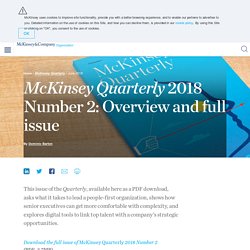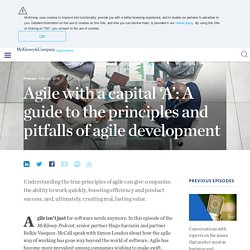

Agile Makes No Sense. Coming of Age Digitally: Learning, Leadership and Legacy. These shifts suggest that companies are beginning to take digital disruption more seriously and make meaningful changes in how they work.

Such shifts persist even when controlling for company age and other organizational characteristics, and may anticipate even greater changes in the years to come. It is possible that many companies have not responded to digital disruption sooner because their competitors weren’t responding, either. Now that some companies have started to move more aggressively to adapt their organization to a digital world, it may mean that others may soon follow in response.
As we saw in the John Hancock example, companies may be reluctant to adapt while they are successful. If your company is not making meaningful steps to become more digitally mature, our data suggests that now may be the time to start to take action. We might be wary of overinterpreting these trends if they weren’t backed up by anecdotal data from our interviews. Quarterly 2018 Number 2: Overview and full issue. This issue of the Quarterly, available here as a PDF download, asks what it takes to lead a people-first organization, shows how senior executives can get more comfortable with complexity, and explores digital tools to link top talent with a company’s strategic opportunities.

Download the full issue of McKinsey Quarterly 2018 Number 2 (PDF–3.7MB). This issue of McKinsey Quarterly will be the last published during my tenure as McKinsey’s global managing partner. Over the nine years I have been in this role, I have been privileged to meet with more than 2,000 CEOs and senior government and social-sector leaders around the world. I always ask the leaders I meet two questions: First, what advice would you want to give to your younger self? Second, what are the top two or three issues on your mind now?
Nearly every leader says talent is his or her company’s top priority, but what does it mean to be a talent-first CEO? The Age of Agile (2018) by Stephen Denning - Book Summary. How Agile Is Your Organization? - Bain & Company Interactive Diagnostic. How concept sprints can improve customer-experience innovation. The concept sprint is a fast five-day process for cross-functional teams to brainstorm, define, and model new approaches to business issues.

Here’s how it works. Companies don’t have an “idea” problem; most companies have plenty of good ideas. But they do have a “get the idea to market” problem. That’s because business leaders too often put too much weight on analysis at a time where they have the least information, spend time aligning stakeholders rather than moving quickly to practical evaluation, or don’t pay enough attention to what products can create real value. A concept sprint addresses that shortfall through a set of activities that turn an “idea” into something that has a greater chance of seeing the light of day and succeeding in the marketplace. Not unlike Google Ventures’ Design Sprint, the concept sprint tailors the essence of a start-up’s innovation culture (agility, speed, and fearlessness) to the business realities of larger, more complex incumbents. The End of Scale. New technology-driven business models are undercutting the traditional advantages of economies of scale.

But large companies still have strengths to exploit — if they move quickly. For more than a century, economies of scale made the corporation an ideal engine of business. But now, a flurry of important new technologies, accelerated by artificial intelligence (AI), is turning economies of scale inside out. Business in the century ahead will be driven by economies of unscale, in which the traditional competitive advantages of size are turned on their head. Economies of unscale are enabled by two complementary market forces: the emergence of platforms and technologies that can be rented as needed. Investments in scale used to make a lot of sense. These new technologies ushered in the age of scale by enabling mass production and offering access to mass markets.
Scale conferred an enormous competitive advantage. Today, we’re experiencing a new tech surge. Agile with a capital ‘A’: A guide to the principles and pitfalls of agile development. Understanding the true principles of agile can give companies the ability to work quickly, boosting efficiency and product success, and, ultimately, creating real, lasting value.

Agile isn’t just for software nerds anymore. In this episode of the McKinsey Podcast, senior partner Hugo Sarrazin and partner Belkis Vasquez-McCall speak with Simon London about how the agile way of working has gone way beyond the world of software. Agile has become more prevalent among companies wishing to make swift, iterative teamwork central to their change efforts because—if done correctly—it can help people work more efficiently, delivering successful products and creating much more value. Audio Podcast transcript Simon London: Welcome to this edition of the McKinsey Podcast. Hugo Sarrazin: It’s our pleasure. Belkis Vasquez-McCall: My pleasure to be on. Simon London: If you don’t mind, let’s start with a little bit of history. Sidebar.